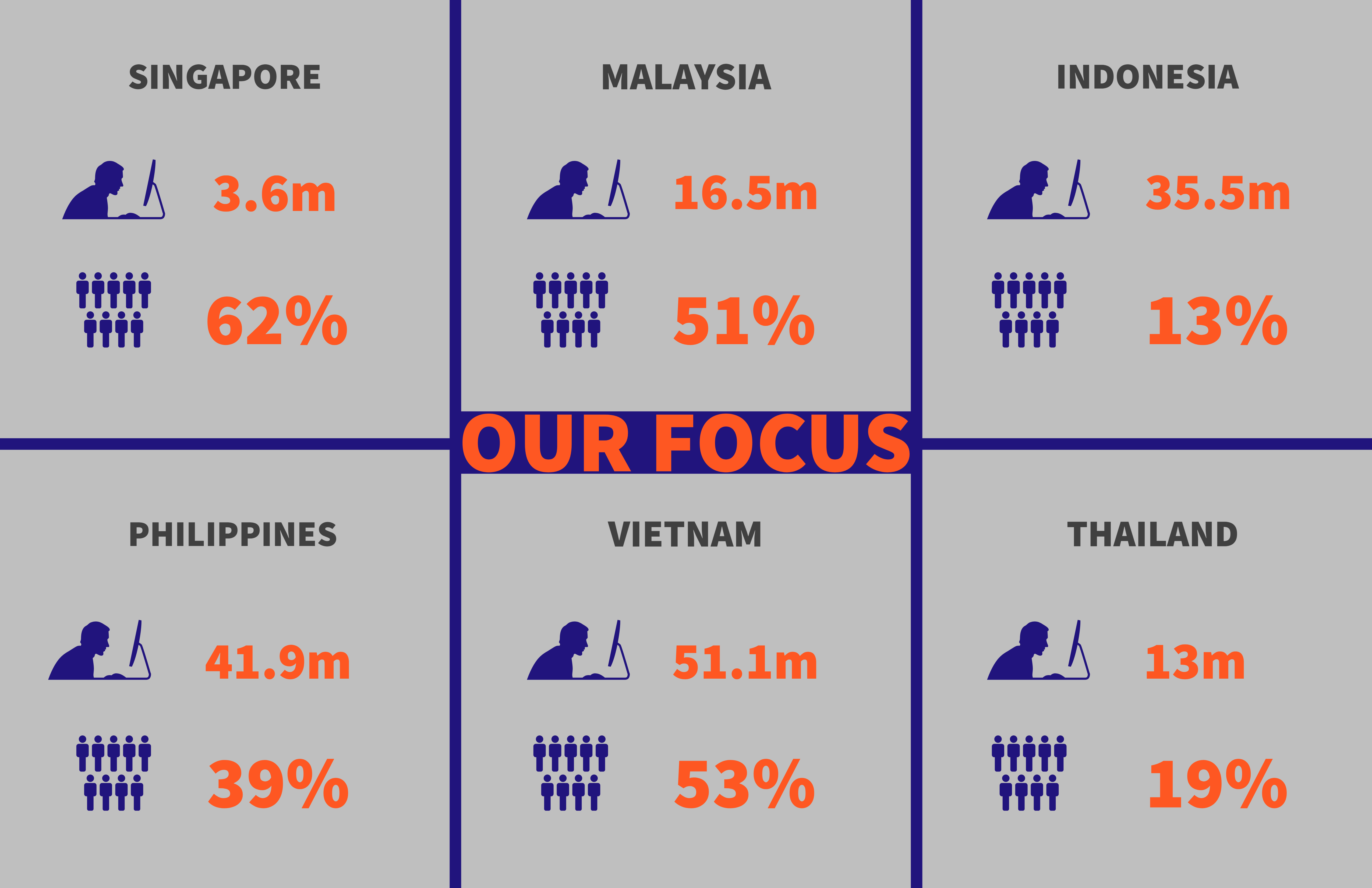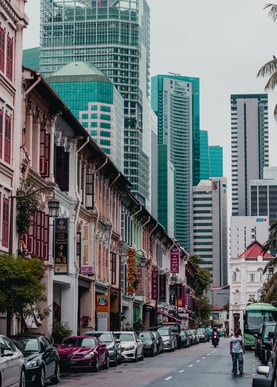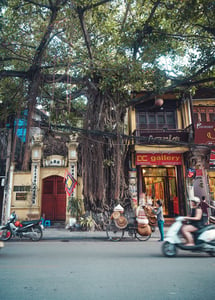“Southeast Asia is the go-to if you search for dynamic growth opportunities” – you’ve probably heard or read it many times. With a population of 641 million people and a GDP per capita of over 4,000 USD, the region draws promising perspectives for many types of businesses. Those based on increasing access to modern technology are thriving – take e-commerce as an example.
With a projected market volume of over 45 billion USD in 2023, Southeast Asian e-commerce is growing fast – and it already accounts for 40% of global e-commerce sales. However, it’s facing several country-specific challenges at the same time.

dipp wouldn’t be dipp if we didn’t take a closer look into the advertising perspective. Analyzing how much is spent annually on digital ads in the countries listed above can give an interesting picture of how actively the products are advertised online to potential buyers.
.jpg?width=5100&name=Digital%20Ads%20Spending%20(6).jpg)
The differences in digital ad spending in the region are significant, and so are the ad characteristics and strategies. As this is not our main focus here, let’s move on to e-commerce industry characteristics and challenges in particular countries’ in the Southeast Asian region, and come back to the advertising topic soon. We will start with the smallest country of them all.
Singapore
Biggest e-commerce platforms: Qoo10, Lazada, Zalora, Carousell, LazzMall, Honestbee, Reebonz, HipVan, Shopee, Taobao.
 With a GDP per capita of 54,000 USD and an average revenue per user (ARPU) of over 1,200 USD, Singaporean e-commerce is highly developed and utilized by more than 60% of its citizens. They buy mainly electronics and fashion. Most of the purchases in Singapore are cross-border. Why? First of all, purchases not exceeding S$400 are exempt from import duties. Secondly, such a high ARPU means that consumers can afford a lot – and they often get it delivered to their house the next day. Amazon Prime Singapore offers free shipping for purchases over $40 (it goes up to $80 for purchases from Amazon USA). The Singaporean government is undertaking initiatives to make the country a Smart Nation where the digital economy is thriving. Seeing the potential, big players have set up their own regional operations there and won't stop to continuously expand their businesses.
With a GDP per capita of 54,000 USD and an average revenue per user (ARPU) of over 1,200 USD, Singaporean e-commerce is highly developed and utilized by more than 60% of its citizens. They buy mainly electronics and fashion. Most of the purchases in Singapore are cross-border. Why? First of all, purchases not exceeding S$400 are exempt from import duties. Secondly, such a high ARPU means that consumers can afford a lot – and they often get it delivered to their house the next day. Amazon Prime Singapore offers free shipping for purchases over $40 (it goes up to $80 for purchases from Amazon USA). The Singaporean government is undertaking initiatives to make the country a Smart Nation where the digital economy is thriving. Seeing the potential, big players have set up their own regional operations there and won't stop to continuously expand their businesses.
Malaysia
Biggest e-commerce platforms: Lazada, 11street, Shopee, Lelong.my, Carousell, Zalora, Qoo10, Fave, Hermo, Mudah.
 Malaysia can be proud of the fact that over 50% of its population is using e-commerce. Although still only 15% of them pay for products with a credit card, they bring in 185 USD on average, which is a high number compared to some of the neighboring nations. Malaysians shop mainly for fashion & beauty, electronics and sports products. The e-commerce adopters are young – 85% of them have not had their 35th birthday yet. The main reasons for them to shop online are price and promotions, as well as the vast product range and available reviews. They seek free shipping, convenience and exclusive deals that cannot be found offline. An interesting time is the month before Ramadan when the masses shop online – and brands need to be prepared for that both with inventories and marketing activities. However, digital marketing is still a challenge for Malaysian e-commerce as a big part of sellers still lack some expertise in this area. There are three nationwide sales events that are worth noting if you plan to sell in the Malaysian market: March 1-31, June 15- Aug 31, and Nov 1- Dec 31. An impressive 95% of people say that they are satisfied with shopping online – it sounds like an interesting phenomenon to contribute to.
Malaysia can be proud of the fact that over 50% of its population is using e-commerce. Although still only 15% of them pay for products with a credit card, they bring in 185 USD on average, which is a high number compared to some of the neighboring nations. Malaysians shop mainly for fashion & beauty, electronics and sports products. The e-commerce adopters are young – 85% of them have not had their 35th birthday yet. The main reasons for them to shop online are price and promotions, as well as the vast product range and available reviews. They seek free shipping, convenience and exclusive deals that cannot be found offline. An interesting time is the month before Ramadan when the masses shop online – and brands need to be prepared for that both with inventories and marketing activities. However, digital marketing is still a challenge for Malaysian e-commerce as a big part of sellers still lack some expertise in this area. There are three nationwide sales events that are worth noting if you plan to sell in the Malaysian market: March 1-31, June 15- Aug 31, and Nov 1- Dec 31. An impressive 95% of people say that they are satisfied with shopping online – it sounds like an interesting phenomenon to contribute to.
Indonesia
Biggest e-commerce platforms: Lazada, Tokopedia, Bukalapak, Blibli, Shopee, JD.id, Elevenia, Bhinneka, Zalora, Qoo10.
 Indonesian e-commerce brings in the highest revenue of 8.59 billion USD which is growing by 17.50% year-over-year. What do Indonesians shop for? Mostly fashion, electronics and furniture & appliances, but products related to hobbies play an important role as well. 55% of Indonesian e-commerce users access it through mobile and most of them pay with bank transfers. Credit card penetration is one of the main challenges – currently only 2.5% of people choose this payment method as their primary one. However, government and tech startups are intensively working on payment systems to solve this difficulty. Shoppers in Indonesia are price sensitive and tend to move from one brand to another for discounts without brand loyalty, which means that sellers need to constantly gain shoppers' attention and cannot count on high brand attachment. Moreover, Indonesians tend to avoid risk which makes them rather late adopters. Small e-commerce sites need to search for creative ways to get people’s trust. What is interesting, many Indonesians are still more comfortable performing transactions with the seller directly (either through social media or various messenger apps). Big e-commerce sites are performing very well in Indonesia and people increasingly use applications such as Go-Jek to order services, such as food delivery or cleaning services.
Indonesian e-commerce brings in the highest revenue of 8.59 billion USD which is growing by 17.50% year-over-year. What do Indonesians shop for? Mostly fashion, electronics and furniture & appliances, but products related to hobbies play an important role as well. 55% of Indonesian e-commerce users access it through mobile and most of them pay with bank transfers. Credit card penetration is one of the main challenges – currently only 2.5% of people choose this payment method as their primary one. However, government and tech startups are intensively working on payment systems to solve this difficulty. Shoppers in Indonesia are price sensitive and tend to move from one brand to another for discounts without brand loyalty, which means that sellers need to constantly gain shoppers' attention and cannot count on high brand attachment. Moreover, Indonesians tend to avoid risk which makes them rather late adopters. Small e-commerce sites need to search for creative ways to get people’s trust. What is interesting, many Indonesians are still more comfortable performing transactions with the seller directly (either through social media or various messenger apps). Big e-commerce sites are performing very well in Indonesia and people increasingly use applications such as Go-Jek to order services, such as food delivery or cleaning services.
Philippines
Biggest e-commerce platforms: Lazada, Shopee, Zalora, Metrodeal, Globe Online Shop, Carousell, Galleon, CDR King.
 Although the Philippines has one of the lowest e-commerce revenues out of all the countries discussed in this article, it brings an impressive number of almost 42 million users to the game. They shop mostly for electronics and fashion – 55% of them on mobile. The biggest challenge that the country is known for is very low credit card penetration and the fact that 86% of Filipinos don’t use banks. Cash-on-delivery, a popular payment method, is costly and inefficient for e-commerce companies operating in the market. However, the Filipino online population is the fastest growing one and people adapt quickly to changes in technology which makes them an interesting market to invest in. Big players such as Carousell and Facebook Marketplace know it. Most of the e-commerce brands in the Philippines use online stores such as Shopify to sell products, as it is an easy and rather cheap way to launch a well-performing store.
Although the Philippines has one of the lowest e-commerce revenues out of all the countries discussed in this article, it brings an impressive number of almost 42 million users to the game. They shop mostly for electronics and fashion – 55% of them on mobile. The biggest challenge that the country is known for is very low credit card penetration and the fact that 86% of Filipinos don’t use banks. Cash-on-delivery, a popular payment method, is costly and inefficient for e-commerce companies operating in the market. However, the Filipino online population is the fastest growing one and people adapt quickly to changes in technology which makes them an interesting market to invest in. Big players such as Carousell and Facebook Marketplace know it. Most of the e-commerce brands in the Philippines use online stores such as Shopify to sell products, as it is an easy and rather cheap way to launch a well-performing store.
Vietnam
Biggest e-commerce platforms: Shopee, Lazada, Tiki, Sendo, Adayroi, Vuivui.
 Vietnamese e-commerce is characterized by a vast majority of people shopping through mobile. Although a large proportion of citizens live in rural areas, which constitutes a big challenge for the industry, it is growing – together with average user spending. Similarly to the Philippines, Vietnam still needs to solve the issue of low credit card penetration, as over 90% of shoppers choose cash-on-delivery as their preferred payment method. Zalora, a popular e-commerce platform for fashion products previously announced withdrawing from Vietnam due to low profitability and was purchased by Nguyen Kim, a large electronics chain. What does it mean for the market? Certain issues need to be improved to avoid rising costs and driving potential customers away. The most important one of them all is probably the country’s poor logistics system which makes transportation costs significantly higher – and price-sensitive customers commonly react to that.
Vietnamese e-commerce is characterized by a vast majority of people shopping through mobile. Although a large proportion of citizens live in rural areas, which constitutes a big challenge for the industry, it is growing – together with average user spending. Similarly to the Philippines, Vietnam still needs to solve the issue of low credit card penetration, as over 90% of shoppers choose cash-on-delivery as their preferred payment method. Zalora, a popular e-commerce platform for fashion products previously announced withdrawing from Vietnam due to low profitability and was purchased by Nguyen Kim, a large electronics chain. What does it mean for the market? Certain issues need to be improved to avoid rising costs and driving potential customers away. The most important one of them all is probably the country’s poor logistics system which makes transportation costs significantly higher – and price-sensitive customers commonly react to that.
Thailand
Biggest e-commerce platforms: Lazada, Shopee, 11street, JIB, Tarad, HomePro, Seed, Advice, Central, Munkong Gadget.
 Thai e-commerce has a revenue of over 3.5 billion USD and is growing by 17.20% year-over-year. Thai shoppers are interested in electronics, fashion, and furniture – 52% through mobile. They rely a lot on social media, with 80% of digital consumers using such platforms to search for products and about half purchasing them directly through social media. The industry’s main challenges are related to customer protection from fake advertising and counterfeit products, as well as legal and regulatory infrastructure. Consumers tend not to trust many online sellers and turn to large and reputable channels instead. Online payment systems are well-developed, reliable, and fast – sellers don’t need to worry too much about having to handle many cash-on-delivery transactions. An important fact to note – Thai shoppers buy heavily at the end of the year.
Thai e-commerce has a revenue of over 3.5 billion USD and is growing by 17.20% year-over-year. Thai shoppers are interested in electronics, fashion, and furniture – 52% through mobile. They rely a lot on social media, with 80% of digital consumers using such platforms to search for products and about half purchasing them directly through social media. The industry’s main challenges are related to customer protection from fake advertising and counterfeit products, as well as legal and regulatory infrastructure. Consumers tend not to trust many online sellers and turn to large and reputable channels instead. Online payment systems are well-developed, reliable, and fast – sellers don’t need to worry too much about having to handle many cash-on-delivery transactions. An important fact to note – Thai shoppers buy heavily at the end of the year.
 Conclusion
Conclusion
Southeast Asia is a highly diverse region and so is its e-commerce industry. More importantly, the one thing that all the countries mentioned above have in common is their dynamic growth. It not only brings the world’s biggest players to the region, but at the same time, it creates opportunities for local businesses to attract digital consumers. The two most important characteristics of Southeast Asia that led to such fast-performing e-commerce development are its young population and an increasing number of mobile devices. There is still a lot of work to do, such as digital payments and logistics. Both startups and governments are occupied with these issues and undertake different initiatives to solve them. Overall, the region is full of promising possibilities for e-commerce businesses and as it continues to grow, it's definitely worth investing in.
---
We have also written a separate article about e-commerce in Malaysia. It features the main types of e-commerce platforms, shoppers' behaviors, challenges and opportunities and details about advertising in the country. If you're interested in this topic, you can access the article here.